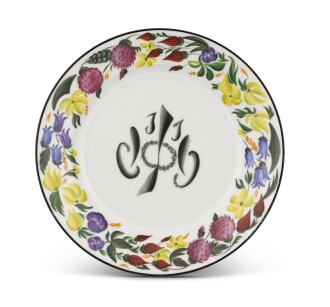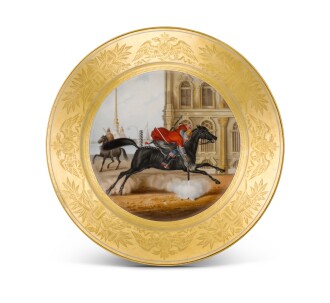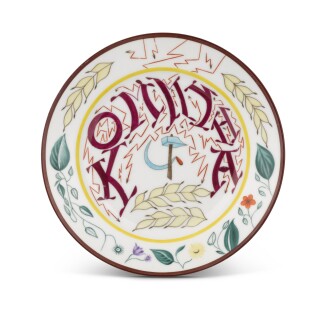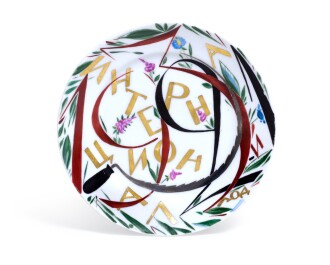T he Russian Works of Art sale brings together an exciting selection over 250 works, highlighted by a rare and important Fabergé gem-set silver and en plein enamel icon of Christ Pantokrator with exceptional provenance. We are also pleased to present several groups from important private European collections of Fabergé, a rare group from the Yusupov palace and a broad selection of porcelain, ranging from the earliest works by the Imperial Porcelain Factory to the Soviet period. This sale is open for online bidding from 9-17 June.
Featured Highlights

In addition to the sophisticated repousse and chased silver design of this Fabergé icon, the design is further enhanced by a variety of carefully chosen and set precious gem-stones. The border incorporates amethyst, citrine, peridot, amber and moonstone. The Ural mountains were a rich resource and Faberge was famous for choosing not the most expensive, but the most interesting stones to enhance its designs. The variety of stones and the seamless way in which they are set would have further contributed to the high cost of this icon.
The Art Nouveau design of this icon incorporates very sophisticated en plein enamelling, in which the enamel has been applied directly to the silver surface. The matted effect is very rich in colour, enhancing the sculptural silverwork of the borders. En plein enamelling is one of the most technically challenging enamelling techniques and the large surface area of the icon necessitated great skill from Fabergé’s craftsmen, in order to prevent the enamel from cracking when fired.
The sides of the icon are engraved with an original inscription detailing the provenance of the piece: ‘To our brother Nikon Alexandrovitch Molchanov / and his wife Maria Alexandrovna as a memento from / sisters and brothers / 28 April 1916' .
This Fabergé icon was given to Nikon Alexandrovitch Molchanov and his wife Maria Alexandrovna Lushnikova by Nikon's brothers and sisters on 28 April 1916. Nikon Molchanov (1871-1945) was a key figure in the Russian tea and sugar trade for almost fifty years. Nikon took over his family business trading tea when he turned eighteen, in the same year he married Maria Alexandrovna Lushnikova. He was a co-owner of the Tomsk firm Sobinnikov & Brothers Molchanovs, founded in 1890. Maria Lushnikova was also from a prominent family and was the second cousin of Wassily Kandinsky, with whom she shared her maternal great-grandfather.
The scratched inventory number next to the Fabergé hallmark is listed in the Imperial Cabinet Record of items for presentation by Emperor Nicholas II to the King and Queen of Montenegro on the occasion of the 50th Anniversary of the King's rule and their Golden Wedding Anniversary in August of 1910.

King Nicholas I of Montenegro with his wife Queen Milena Vukotić, 28 August 1910 This icon is listed as number 6 under icons for possible presentation: 'The Saviour / Fabergé no. 17810' costing 500 roubles. This was a very high price for an icon in 1910.

In the workshops of Fabergé no fewer than 145 new shades of enamel were innovated and employed by the head workmasters to transform functional items such as picture frames, clocks and cane handles into elegant works of art. By applying its fantastic range of colour and guilloché enamel patterns to objects that clients of the famous firm wanted to live alongside, Fabergé created luxurious design and wearable artworks such as their iconic egg pendants. It is this incorporation of the most skilful technical craftsmanship into an elegant daily lifestyle that won Fabergé the patronage of the Imperial Family and Royalty internationally.

Russophile tastemaker Nathalie Farman-Farma is the founder of textile studio Décors Barbares and author of a forthcoming book on interior style. Inspired by Persian and Central Asian motifs, Ballets Russes costumes, and Russian folklore, she employs traditional print-making techniques to create a line of fabrics that mixes Eastern and Western influences with exuberance and romanticism. We asked her to select her top picks from the Russian Works of Art auction, as seen through her unique aesthetic.
“My love for the decorative arts of Russia is expressed in my line of fabrics and in the decoration of my home. I personally collect antique textiles as well as icons and Russian Art and Crafts furniture. There are many items in this sale that make me dream, including two items by Fabergé, an elegant wooden photo frame as well as a quirky fin-de-siècle tea service. I would also chose the floral painted porcelain eggs for a wonderful Easter tablescape and an icon of the Mother of God to hang in my bedroom. I am a great fan of Russian porcelain, especially the dynamic early Soviet production. I would love to collect these plates and line a dining room with them.”

From the second half of the 19th century, in parallel to artists like William Morris, Russia sought to establish a truly Russian art form. The Pan-Slavic style, in which the decorative arts harmonize with their overall interior to produce a total work of art, thrived in the artistic communities of Abramtsevo and Talashkino, as well as in the designs of artists such as Bilibin. These individual workshops often took inspiration from embroidery, ceramics and traditional craftwork and their influence can be seen in the enamelled patterns of Rückert, the Panslavic designs of Fabergé and other silversmiths and in ceramic design during this period. The distinctive and original Russian style that emerged melded the fine and decorative arts into one truly artistic interior.

This rare and historic collection of silver from the private collection of Prince Felix Yusupov and his wife, Princess Irina Alexandrovna appears on the market for the first time since it was acquired by Edward C. Finch in Russia in 1927.

An aristocrat and husband to Emperor Nicholas II’s niece, Prince Felix is perhaps best known for his participation in the assassination of Rasputin. Richer even than the Romanovs, the Yusupov family amassed their fortune over many generations. Their fortune included four palaces in Saint Petersburg, three palaces in Moscow, thirty-seven estates throughout Russia, coal and iron-ore mines, plants and factories, mills and oil fields on the Caspian Sea. Forced into exile following the Emperor’s abdication, Felix and Irina fled Russia with very few of their possessions.

Before fleeing in autumn 1917, Prince Felix Yusupov sought to conceal a portion of his family's treasures from the Revolutionaries. Jewellery and art objects, including the Yusupov Scandinavian service (lot 149), were walled up under a staircase of the Yusupov's Moscow house, a former hunting lodge of Ivan the Terrible (see Prince Felix Yusupov, Lost Splendor, New York, 2014, p. 277). The Bolsheviks occupied most of the Yusupov’s properties, including the mansion in central Moscow. It was not until 1925 during repairs to the building that a secret storage, containing jewellery, gold and silver, was found under the staircase.
The Soviet government held a very pragmatic view of Imperial treasures, selling them abroad or even melting them down. Thankfully, some of this group was salvaged in September 1927, when a wealthy American traveller Edward C. Finch bought it from a Soviet shop to benefit Russian children. It was during his travels in Russia that Edwards C. Finch also collected the present group of porcelain from the Farm Palace Banquet Service (lots 151-157).
This group of treasures travelled to the United States, where it remained in Edward C. Finch’s private family collection, from which it is now presented.

As both the setting for intellectual discourse and relaxation, the traditional literary salon of the early 19th century increasingly incorporated parlour games by the early 1900s. As a reprieve from the pressures of industrialized society, the games parlour provided a setting in which to relax surrounded by luxury drinkware, cigar boxes, games, books and friends.
Single-Owner Collections
Property of a Gentleman
Property from an Important German Collection
Property from an Important Collection, London































































































